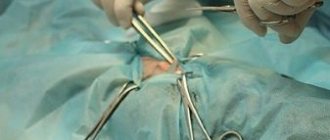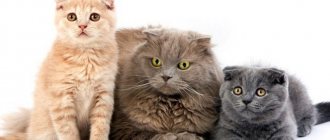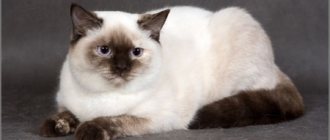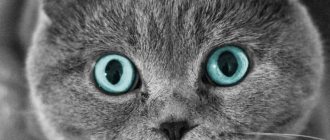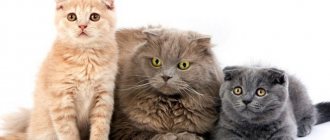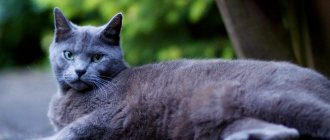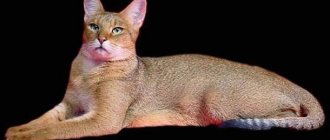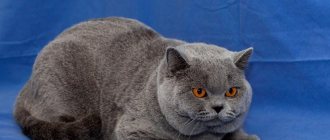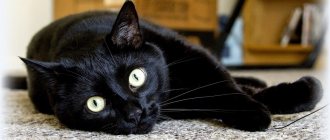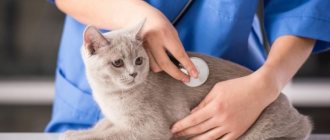Animal selection requires mandatory documentary confirmation. For ease of classification, felinology has adopted codes (encodings) for cat breeds and colors. Coding has general principles and indices.
The breed is designated by three capital English
letters.
The main color is in lowercase English letters
. Color group, eye color, ear shape, tail shape - in pairs of numbers. The encoding must be included in the documents on the breeding origin of the animal (pedigree, metrics). The order of numbers may differ in different felinological systems.
XXX xx NN NN NN (NN)
XXX
– breed code;
xx
– coding of the main color;
NN
– digital designation of color, eye color, ear shape, etc.
In the IFA system, the arrangement of numbers in a color is accepted according to its name, for example, the color “black silver marbled bicolor with yellow eyes” - ns 22 03 62
(
n
– black,
s
– silver,
22
– marbled,
03
– bicolor,
62
– orange/yellow eye color).
Numerical designation of colors (NN – in general coding)
- The number 0 begins to indicate the presence of white in color
- The number 1 begins to indicate the degree of tipping
- The designation of the design variant begins with the number 2
- The number 3 begins to indicate the point color variant
- The number 5 begins to indicate the length of the tail (not always indicated)
- The number 6 begins to indicate eye color (not always indicated)
- The number 7 begins to indicate the shape of the ears.
| White quantity coding (bicolor scheme) |
| 01 – harlequin |
| 02 – harlequin |
| 03 – bicolor |
| 09 – nonspecific white spots (“medallion”, “socks”) |
| Tipped color coding |
| 11 – closed |
| 22 – veiled (chinchilla, cameo) |
| Tabby pattern encoding |
| 21 – indeterminate tabby (for sphinxes, vans, harlequins, color-points) |
| 22 – marble |
| 23 – striped |
| 24 – spotted |
| 25 – ticked |
| Color point color coding |
| 31 – Burmese pointing |
| 32 – Tonkinese pointing |
| 33 – Siamese pointing |
| Tail length coding |
| 51 – tailless (only for the Manx breed) |
| 52 – short tail (for the bobtail breed) |
| 53 – pushed back bob |
| 54 – normal tail length |
| Eye color coding |
| 61 – blue eyes |
| 62 – orange eyes |
| 63 – differently colored eyes (necessarily one blue) |
| 64 – green eyes |
| 65 – Burmese eye color |
| 66 – Tonkinese eye color |
| 67 – Siamese eye color |
| Ear shape coding |
| 71 – straight |
| 72 – ears curled back (curl) |
| 73 – ears folded forward (fold) |
Care and maintenance
The basis of care is a balanced diet.
When purchasing a kitten, you need to ask the breeder what food the animal is accustomed to. Using this food, you can gradually switch to the desired mode. Up to four months, the kitten should eat at least four times a day, after 8 months - twice. If the animal receives natural food, it should include fermented milk products, offal, and lean meat. Do not give cream or natural milk. The former have a high fat content, and the latter is not absorbed by the body of an adult cat. Suitable by-products include chicken gizzards, hearts, and beef liver. Meat – chicken, veal, turkey, rabbit. Pork has a high fat content and can lead to excess weight gain.
As a side dish - porridge. You can give your cat buckwheat, oats, rice. It's great to include vegetables in your diet. They can be raw or boiled. Fish can only be sea, low-fat, boiled. The finished food has a balanced composition, containing all the substances a cat needs. The food can be dry or wet. It is better to choose premium, super-premium, holistic food.
Veterinarians strictly prohibit mixing these two regimens. This can cause problems in the digestive system. Many Scottish dogs are prone to overeating. You should not overfeed your pet - extra calories weaken the heart system. Also, care is important for a cat, which consists of certain hygiene procedures.
brindle tabby
Education and training
A pet is not a soft toy. When bringing home a Scotsman, you need to know the basic rules of communication, keeping, and raising a pet. This breed has developed intelligence and quick wits. You can teach your kitten to simple commands, but you need to know some nuances. A kitten left alone can cause mayhem and chaos.
There is no need to hit or scream at the animal. It will not understand what the owner wants from it. You need to set aside some time and devote it to your pet. You need to buy toys for him, a play corner, tennis balls are perfect. The kitten perceives them as its prey. If you play with him during the day or in the evening, at night the pet will sleep peacefully without disturbing people.
If the kitten starts biting or chewing furniture, this must be strictly stopped. This can be done in a stern voice. If the furniture is suffering, it can be treated with sprays with the smell of citrus fruits; cats cannot tolerate such aromas. Scottish Folds get accustomed to the litter box very quickly, you just need to show them the place of the toilet. Kittens usually understand everything the first time.
How coat color affects the character of a Scotsman
When purchasing a pet, you should not chase fashion; it is better to trust your preferences and tastes. The main thing is that the cat turns out to be “yours” in temperament and character. By the way, some cat owners are sure that the color of the fur affects the behavior of the animal and leaves an imprint on its character.
White and light colored
You want to cuddle these babies endlessly. But they, as a rule, do not like increased attention to themselves. Although they are very loyal to the owner, they are extremely wary and wary of other people. Among some peoples there is a belief that a white cat brings good luck. Whether this is true or not is not known for certain. But the white color can cause a lot of problems for the cats themselves, since 5% of all snow-white cats are born completely deaf. Previously, it was believed that deafness was the fate of absolutely all white-furred tails, but later scientists proved that this is not so. But when buying such a kitten, you should still be more careful.
Black
Despite all the existing prejudices and myths regarding black cats, in practice they are one of the friendliest towards people. They like to stay close to their owner all their free time and always keep him in sight. Charcoal cats are wise, quick-witted, and keenly aware of a person’s mood.
Redheads
Such animals are a ray of sunshine in your home. It is believed that a ginger cat in the home is the key to an indispensable increase in well-being. Those with fiery fur are very playful, willful, cheerful and curious creatures. The golden shades of fur that are fashionable today are characteristic of more formidable animals, whose disposition can hardly be called friendly. And golden Siamese cats are generally considered the worst tailed cats.
Blue and silver
Silver and blue fluffies are real aristocrats. Calm, balanced, noble. They love their owner devotedly, although they are not always ready to demonstrate this publicly. It is believed that these four-legged pets are able to calm and relieve stress in humans. In addition, cats of this color are absolutely not vindictive.
Two-color
Such cats are most in demand among buyers. In addition to their interesting color, they have an easy-going disposition, are friendly, and kind even towards children. Bicolor cats love their owners very much and get along well with other pets.
Calicos, tortoiseshells
The English name for the color is torti. On the fur of the “turtles” dark spots are intricately combined with light ones. The variegated coloring must be distributed evenly over the body, which distinguishes torties from tricolor cats.
In Scottish Folds, the “tortoise” pattern occurs in variations:
- black-red;
- creamy lilac;
- chocolate red;
- creamy blue.
Interestingly, only cats can be “turtles”. In cats, this is a genetic mutation indicating infertility.
It is known that predominantly cats are born this way, and a male tri-colored individual is a rare occurrence and without the possibility of procreation. Tortoiseshell Scottish Folds are distinguished by alternating red and black spots.
Color variations are possible, for example, lightening, then areas of the coat will be blue and cream. Breeders strive to produce “turtles” with uniform coloring and a symmetrical arrangement of spots.
Calicos are rare among Scottish Folds, but the cats look very impressive. They are recognized by their white background and colored spots. There may also be bright colors and weakened ones. Diluted Calico - there is much more white base.
Eye color depends on the base color and the distribution of spots on the head and face. In any case, a bright and shining color is welcome.
Calico cats are prized for their diversity of offspring. The name of the color in translation is “patchwork”, which fully describes the appearance of the animal.
Caring for a pregnant cat
Scottish cats themselves take precautionary steps during pregnancy, lead a sedentary lifestyle, and are extremely neat and clean. The owner needs to help the cat during this period, follow simple rules:
- Transfer to extra-premium food from specially developed lines for pregnant and lactating cats.
- It is strictly forbidden to treat Scots with medications without the recommendation of a veterinarian.
- Do not palpate the cat yourself; you may harm the embryos. A specialist uses an ultrasound to determine the gestational age, the number of embryos, and the approximate day of birth.
- Street walks are prohibited to prevent the pet from becoming infected with infectious diseases. Ventilate the room more often, but protect the tartan from drafts.
Nutrition
The cat’s diet does not change, only the volumes and quantities are adjusted, minerals, vitamins, and a lot of protein are added.
- after 3 weeks, the increased portion of food is divided into 4 doses;
- by the middle of pregnancy, they gradually double the daily portion of food, but do not make the cat become obese, which can complicate childbirth;
- in the final stage before childbirth, they return to the normal diet that they had before pregnancy.
After giving birth, the cat needs simple food that is digestible by the body. The cat is fed up to 5 times a day, fish oil, calcium and phosphorus supplements are added to the food, and milk and fermented milk products are given.
Cost of Scottish Fold
When buying Scottish Fold kittens, it is important to keep in mind that longhaired Folds (Highland Fold) cost up to 2 times more than shorthaired ones. Average prices for Scottish Fold kittens in Moscow are:
Average prices for Scottish Fold kittens in Moscow are:
- Without pedigree: from 4,000 rubles
- Standard: from 10,000 to 40,000 rubles
Video
Sources
- https://ru.wikipedia.org/wiki/Scottish_fold_cathttps://dogcatfan.com/155-scottish-fold.htmlhttps://kot-pes.com/shotlandskij-vislouxij-kot-foto-komok-schastya/https: //petsik.ru/catbreed-scottishfold.htmlhttps://murkote.com/skottish-fold/
Tabby (tabby)
Such cats have stripes of an unusual shape and a different color than the main color. The most common marks are on the forehead, for example, in the shape of the letter M, light spots on the back of the ears, a necklace on the chest, rings on the paws and tail, curls on the cheeks, eyes outlined as if with shadows.
Breeders distinguish several variants of tabby. According to the type of pattern, they are marbled (shaded), tiger (mackerel) and spotted (spotted).
There is a complex classification of Scots tabby dogs based on combined colors and shades. They are presented in the table below:
Pattern colorSilverSolid solid or plain
This type of coloring is the most common among Scottish folds and straights. The animal's fur is uniformly colored with one color; small spots and stripes are not allowed. Single-colored individuals should not have a pale marbled pattern on their coat; this is considered a fault.
The following solid colors are available:
- Blue. The most popular color, in cats it varies from gray to blue, while the eyes should be a rich amber shade. The coat is colored evenly, without interspersed hairs of a different shade.
- Lilac. The second most popular color among Scots, the hairs are gray with a bluish-pinkish tint. Sometimes this color is called pale café au lait, but this description is not entirely correct. The animal's eyes can be either amber or bright yellow.
- White. Cats have a uniform, rich color without interspersing other shades. Such cats may have blue or multi-colored eyes; this feature is not considered a defect.
- Black, or ebony. Uniform and rich black color, without single inclusions of hairs of other shades. Eyes can be either a rich copper shade or bright yellow.
- Chocolate. A solid warm brown shade, with the undercoat not being lighter than the coat. Faded patterns or stripes are not allowed. The animal's eyes should be a rich amber color.
- Cinnamon. Very similar to chocolate, but less intense. Rare and beautiful uniform color. In order not to be mistaken, you need to examine the nose and pads on the animal’s paws - in cinnamon they are always pink.
- Faun, or deer. A very light version of cinnamon, this shade can be described as light beige with notes of cocoa. It is often confused with lilac, but the latter has a clearly visible mauve undertone.
- Cream. This is a combination of whitened red with a delicate peach undertone. In animals, uniformity of color is valued, while fuzzy patterns on the paws and head are acceptable. Saturated speckling is considered a fault.
- Red. He is sometimes called red. This shade is very rare, since during selection it is not easy to obtain an animal with a uniform color. The color can be described as a moderate to rich variation of red. Animals should not have a pattern on the head or limbs; an unevenly colored tail is considered a serious fault.
Solid colors, despite their apparent simplicity, are strictly judged at animal shows. If you plan to purchase an animal for a breeding breed, it makes sense to wait for the molt and buy a raised kitten to make sure that the color is uniform and there are no spots.
Pros and cons of Scottish Fold cats
The advantages of the Scottish Fold are:
- appearance;
- thick plush fur, reminiscent of a plush toy;
- calm character;
- cleanliness;
- learning ability
color point scottish fleed
They also have their disadvantages:
- ear parasites due to their characteristic shape;
- picky eating;
- independence from the owner.
As you can see, Scottish cats have more advantages. These animals cannot stand loneliness, for them it is psychological pressure, the animal can become depressed and refuse to eat. Kittens and young individuals are especially vulnerable. Communication with people is critical for them. The character itself is phlegmatic, calm, without excessive activity. At the same time, they are affectionate, patient and good-natured.
I like2I don't like
Description of the breed
Among the representatives of the breed, gray fold-eared cats occupy a special place. They look a bit like the British Shorthair breed, so there is often some confusion. The Scottish cat is a medium-sized animal that weighs up to 6–8 kg. There are also other distinctive features.
The physique of such cats is quite stocky, and the chest is large. The animal's back is wide, its hips are massive, and its neck is very short and thick. The paws are also quite wide and thick, and are also extremely well developed. The flexible tail can be either short or long. The head of such beauties looks a little like a ball. The eyes of fold-eared cats are widely spaced and have a round shape, which gives the animal a slightly surprised look. Their nose is small, and their chin is quite powerful. The fur of these animals is short and soft, a bit like plush. However, among them you can also find cats whose coats are long and fluffy. Since their ears are very small, they are practically invisible behind their long fur.
That's why these rare Scots look more like a ball of fur. The small ears of Scottish gray cats are very attractive. After all, they are practically broken in half and cover the entire auricle. The uniqueness of such cute animals also lies in the fact that their colors can be very diverse.
There are solid and spotted specimens.
A little about genetics
It is especially interesting how the color of a Scottish kitten is formed and what it depends on. In the genome of this breed, two colors predominate, responsible for the color of the animal - red and black. Anyone can, under certain conditions beyond a person’s control, become dominant. Such a gene suppresses weak ones, which are called recessive. There is also a third gene, the so-called diluent. It is responsible for the degree of pigmentation saturation.
When these genes are combined with each other, the most unusual coat colors of an animal can appear. It is extremely difficult to determine in the first weeks what color a kitten will have in the future. The shade he was born with is not constant and may change as he grows older. In some cases, dramatic changes occur. The change in shade begins at six months and lasts up to two years. The table below shows options for crossing the colors of parents, according to which their offspring inherits the coat color.
How the coat colors of the offspring are crossed.
Basic colors
Plain (solid, solid) - the description of this type of shade can be understood based on its name. Cats of this color have a single, solid tone that does not imply the presence of other colors (the complete absence of inclusions, spots, stripes and everything else). If other colors are still present, then it is necessary to carefully examine the inclusion itself - it can indicate either a different color variant or indicate a congenital defect, which reduces the cost of the individual and the ratings at shows.
Solid colors are divided into the following types.
Blue (what ordinary people mistake for grey). Not so long ago, the blue color was considered classic for Scottish cats, but over time, other solid color options appeared. There are different variations: some are closer to gray, others to cyan and blue. Kittens can have a variety of patterns on their fur, which should disappear within a few months of birth. The eyes are amber, the nose and paw pads match the color scheme of the fur.
Point (point)
The more common name for this color is color point. It is characterized by the fact that the main color of the animal turns into a darker color at the tip of the muzzle, tail, ears and paws. This is due to the fact that in the blood of such animals there is a special gene that affects the darkening of the hair in those parts of the body where the temperature is low.
There are several variations of this color, which are shown in the table below, there may be others:
| You cannot start topics You cannot reply to messages You cannot edit your messages You cannot delete your messages You cannot vote in polls You cannot attach files You can download files | ||
| Color name, photo | Main color | Additional color |
| Seal Point |
Smoky
Other names for the color are smokey and smoky. This is the so-called typing color: the base of the hair is light, almost white, and the tip is dark.
Among the Scots, smokey is classified as silver. The color does not allow patterns on the coat - brindle, spotted, tortoiseshell. It is easy to distinguish a smoky color from a solid color - you need to part the fur. In a smoky, it is ⅔ colored - the base of the hairs is always light.
The main variations of “smoke”:
- black;
- blue;
- chocolate.
The undercoat is white or almost white, the eyes are like gold.
The rest of the colors are as follows:
- Black. The fur is black, with white parts near the bulbs. The nose and pads are in the same color scheme as the fur.
- Blue. The undercoat is white, and the edge is covered with a cold gray coating, the nose and pads are in the same color scheme.
- Cameo. The undercoat is snow-white, fur with a fiery tint. The nose, pads and eyeliner are pink.
Shaded colors
The undercoat is almost white, the ends of the hairs are whitish. Almost the entire edge is covered with one color or another, only the chin and abdomen are completely light.
Shaded can be:
Golden. The undercoat is light peach, the fur has a golden glow. The eyes are green, the paw pads and nose are dark chocolate.
Silver. The undercoat is snow-white, the tips of the hairs are dark gray. The eyes are greenish, edged with black. The last feature is characteristic only of the silver variety; other Scottish shaded colors do not have eyeliner. The nose mirror is brick-colored. Black edging of mouth and nose, pads.
Red, aka Cameo. This variety of shaded color has a snow-white undercoat, and there is a dark red coating on the coat. Only the muzzle and chin, the abdomen and the underside of the tail remain completely light. The eyes are like amber. The nose, eyeliner and pads are pinkish.
Birth of a Scottish cat
In order for the birth of a Scottish Fold cat to be successful, the owner must prepare in advance:
- The place where the birth will take place is covered with a film and a cloth on top;
- Prepare things and tools that may be needed during childbirth: scissors, thread, Vaseline.
Cats cope during childbirth on their own, instinctively. The owner must observe the process and intervene when:
- The cat has not expelled the placenta; she is helped with Vaseline-lubricated hands;
- If necessary, trim the umbilical cord by 2 cm and tie it with thread.
Attention! If contractions last more than a day, and the kittens are still not born, urgently seek help from a veterinarian. Kittens and mother may be seriously harmed
First stage of labor
It takes a long time and can last up to 12 hours. It all starts with a slight dilatation of the cervix. The water breaks, abdominal contractions begin, the temperature drops, these are signs that signal the impending birth. The female behaves restlessly, meows pitifully, and strains. As a result of contractions, the fetus moves, the uterus expands more and more, and the fetus gradually enters the vagina.
Second stage of labor
After prolonged contractions, the uterus expands significantly and the head of the first kitten appears in the water sac (amnion), when the sac ruptures, the passageways are lubricated, and the kitten is born. The normal, typical position of a kitten at birth is head and paws forward.
As soon as the head appears, the cat pushes the fetus forward with regular attempts, rubs the umbilical cord with its teeth, twists it in such a way, which stops the bleeding. First of all, he licks the cub’s face, clearing the respiratory channels. A newborn kitten takes a breath and begins to breathe on its own.
Third stage of labor
After each kitten is born, the placenta separates. Following instinct, the cat eats the afterbirth. If there are a lot of kittens, it is better to limit the amount of placenta consumed; the pet’s digestion may be impaired.
The birth of each pursuing child usually follows in 20-30 minutes, but there are also long breaks, up to a day. The cat calmly grooms, licks the newly born, and then the birth continues, until the last kitten in lambing.
Postpartum period
After birth, while licking the last baby, the cat lies down on its side, the kittens instinctively crawl each to their own nipple. The sucking process causes the uterus to contract, and the body begins to produce colostrum, a nutrient containing antibodies.
When there are few kittens
When Scottish cats give birth for the first time, there are usually few kittens in the litter, from 1 to 3. This is explained by the fact that the young animal is not yet fully grown, and the number of eggs produced directly depends on puberty.
The photo shows newborn Scottish kittens.
Why are there so many kittens?
An adult Scottish cat can have many kittens. Recently, breeders have been trying to increase the conception of offspring with the help of medications. Using homeopathic and hormonal drugs such as Gamavit, Ovariovit, it increases the production of eggs.
https://youtube.com/watch?v=YFwTlhWGp_0%3F
Plain or solid
A solid color means that there is no additional color either as a base tone or as an undertone. Occasionally, single-colored Scots may have streaks or spots on the face, but the quality of the coat in this case is sharply reduced. In another way, solid colors are called solid, and they come in the following types:
- snow-white. The fur of such cats is perfectly white, the nose is pink, and the eyes are amber or golden;
- black Scottish cats have paw pads and nose that match the color of their coat;
- gray or blue. The eyes of Scots of this color are amber, and the pads of their paws are a covering shade;
- lilac is a mixture of light gray and warm cream;
- a red fold-eared kitten can also be called red, and have a nose and paws of a similar shade;
- Cinnamon kittens resemble saffron milk caps, but their fur is darker in color, similar in shade to rust or the famous spice cinnamon.
Solid colored cats have a number of advantages and disadvantages. As for the advantages, the solid deep color is very much appreciated among show kittens. Moreover, this color is easier to control at the mating stage - it will be easier for you to predict what result you will get.
Appearance
The cat is of medium size, strong, harmonious build. The coat is short, thick, elastic, very soft to the touch, elastic, lying close to the body. The color can be very diverse: single-color (blue, black, white, sand, chocolate (milk chocolate color), cream), multi-color (harlequin, van), striped (various tabby patterns, marbled, spotted, brindle).
There are several groups of Scottish Fold colors that differ in the color and nature of the stripes and spots:
Solid (solid). This is a plain color of the body without any patterns. Cats can be black with shades ranging from jet black to taupe, blue, white, gray, red, sand, chocolate (milk chocolate color) and cream. Smoky. Such cats have a uniform guard hair color and a silvery undercoat. Tortoiseshells. Characterized by a chaotic arrangement of various spots, rich colors (red, cream and black)
It is important that the colors are harmoniously combined and the spots are evenly distributed throughout the body. Chinchilla. The color is characterized by the fact that one eighth of the hair is colored, the rest remains white. Tabby
This color is characterized by the presence of a brindle, marbled, spotted or striped pattern. Moreover, the nature of the marble pattern suggests a symmetrical arrangement of spots and the obligatory presence on the face of a spot similar to the letter “M”. With the brindle color, parallel stripes of color are located vertically throughout the body. The Whiskas color became especially popular after the Whiskas food advertisement. The main color is silver, the stripes range from dark gray to black. Bicolor. With this color, most of the cat's body is white. It is important that the belly, paws, part of the muzzle, neck, chin and chest are white. Colorpoint. With this color, the protruding parts of the body are painted in rich colors: paws, tail, muzzle, ears.
The ears are set wide and folded so that their upper part covers the ear opening, that is, they hang down. The more tightly the ears are pressed to the head, the more valuable the representative of this breed is.
The eyes are large, round, open, and set wide apart. The eyes can be of different colors, but must match the coat color. They can be from yellow to amber, blue or emerald. Occasionally you come across cats with different colored eyes - usually white with blue and yellow eyes.
The body is stretched out, graceful, different from the British stocky type. Shoulders and hips are the same width, the chest is voluminous and wide. The legs are of medium length to quite long, strong, with round graceful paws.
The tail is of medium length, thick at the base and pointed at the end. Individuals with a movable tail are valued, since changes in the joints are possible in this breed. Some Scottish Fold cats have bushier and thicker tails. At first this was considered a positive trait. But at the same time, thickening of the hind legs was also observed, which interfered with the cat’s normal gait. Today this sign is undesirable; moreover, it affects the evaluation of the cat and is even a reason for disqualification at the show.
It is important!
It is not advisable to engage in breeding without the appropriate knowledge. The average person does not know what a hook on the tail looks like, how to recognize early dysplasia (which cannot be treated, the animal is disabled for life), undershots, undershots, polydactyly and much more, which makes cats unsuitable for breeding. Especially if it is a Scottish breed (Scots are prone to genetic problems of the musculoskeletal system - MURCOTICS). To do this, we need breeding assessment sheets from an expert from exhibitions to eliminate disqualifying factors for further breeding. You need permission from the club in which the breeding animals must belong. Documents are required for all animals. After all, if there are no documents, then there is no breed, and there are plenty of outbred or phenotypic (only outwardly similar to Scots - MURKOTICS) on the streets and in shelters.
Source
